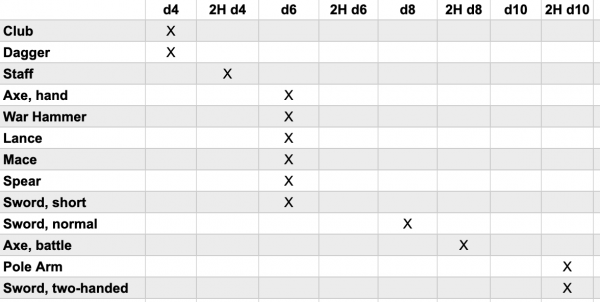
On Wandering DMs yesterday Dan and I were discussing the differences between OD&D and B/X and we got into the topic of equipment. Back in the day when I was running B/X regularly I realized that encumbrance info in B/X was lacking and was annoyed that equipment info is split up throughout the text in three different charts – costs, encumbrance, and damage. I created a unified table that I use regularly, but couldn’t find where it was on this blog. So off the top, here’s my current expanded B/X equipment tables.
But why was I looking for it? One of the interesting differences between OD&D and B/X D&D is the usability of equipment by race. This is perhaps extra important in B/X due to the race-as-class feature – you essentially have three variations of fighter in the game – fighter, dwarf, and halfling. Assuming the human fighter is the baseline, dwarves and halflings each blend in their own sets of benefits – infravision, extra languages, detection abilities, hiding, bonuses to saves, etc. To counter-balance this, there some requirements – minimum stats to qualify for these classes – and restrictions including level limit and inability to use large weapons.
In my own games I eventually house-ruled out race-as-class, detailed in the BXCL. I also got rid of the racial level limits, partly because I feel this is moot when you never actually play beyond 10th level, and ultimately I reused that restriction for multi-classing. This means when playing a single-class fighter, the only reason not to be a dwarf or halfling is the stat requirements. I don’t like the idea that this pushes high Dex/Con fighter types towards one of those choices – would you ever see a single-class human fighter with high Dex and Con?
I did add an XP tax in the BXCL – it costs 10% more XP to level up as a dwarf or halfling. I felt like this was a pretty good interpretation of the differences in the XP charts in B/X when using RAW race as class. That said, I think this cost is small enough that most players gloss over it very quickly. So that leaves us with the weapon limitation. According to the text, the only weapons off limits for dwarves and halflings is the long bow and the two-handed sword. Personally, I extend that include the pole arm as well, both because it seems logical, and I liked the idea that this leaves access to d10 damage weapons as a benefit to playing human fighters. But you have to give up your shield to get it, so when it comes to using a one-handed weapon, a normal sword is clearly the right choice regardless.
This has bothered me for a while, but I wasn’t sure what exactly I wanted to do about it. Finally, I made myself a quick chart of melee weapons grouped by number of hands required to use them and damage they do:

Honestly I came at this thinking the problem was the battle ax – it’s two handed and only does d8 damage. It is also the only two-handed weapon available to dwarves and halflings. But why on earth would you choose that over the obviously superior normal sword? It’s the only one-handed weapon that does d8 damage and it’s available to everyone.
So here’s another idea – what if I ruled that the normal sword is so big that dwarves and halflings can only wield it two-handed? For those classes this would mean the only way to get a d8 damage weapon is to choose a two-handed one: sword or battle ax. All the one-handed weapons (short sword, mace, war hammer, hand axe) are stuck at d6 damage. So as a halfling or dwarf fighter you can either wield a one-handed weapon for d6 damage or a two-handed weapon for d8. A human fighter now gets an interesting advantage – both categories get bumped up a die type with one handed d8 damage from a sword and d10 from two-handed swords and pole arms.
Another interesting side-effect here is that the short sword finally has a use case. Honestly, I can’t think of any reason in BX D&D that any character ever chose the short sword. The mace and hammer often get used by clerics as non-edged one-handed options, and the hand axe is often picked up as a throwable option by fighters. But the short sword? I honestly have never seen anyone choose it.
There is still part of me that wants to go fully abstract here as I did in the rules for Ten Dead Rats, where weapon stats are dictated by size. One handed “hand weapons” do d6 and two-handed “great weapons” do d8. The choice of what kind of weapon they are – sword, ax, club, table leg, whatever – is purely one of style. But I worry going too far off the deep end starts to break some of the nostalgia factor of this game for me, which is definitely one of the reasons I prefer playing BX over say any of the retro-clones.
So I’m writing this here to try it on for size – how do I feel about ruling that normal swords are two-handed for dwarves and halflings? Hmm… not bad honestly. Worth a try at least once I think. Though it doesn’t solve that pesky elf problem.



Paul,
Agree with the costs 10% more XP to level up as a dwarf or halfling. I looked up the BX rules for battle axe as I was surprised about the two-handed classification. I also looked up the Viking and English battle axe and saw that there were one- and two-handed battle axes. The one-handed axes were much bigger than the hand axe.
Yeah, I don’t think any other edition ever called the battle axe two handed, though by 3rd edition we start to see more variety of axes (EG the great axe).
” how do I feel about ruling that normal swords are two-handed for dwarves and elves? ”
Halflings?
LOL, yup! Thanks for the catch, fixing it now.
I do like it though, it gives a nod to the whole weapon size thing without becoming a whole subsystem.